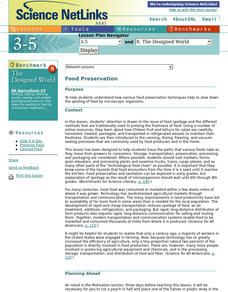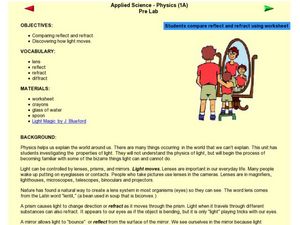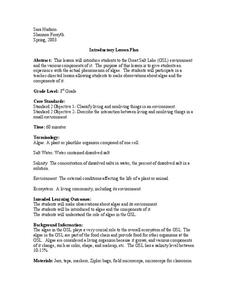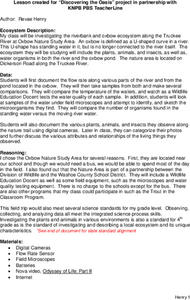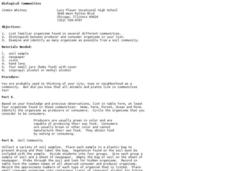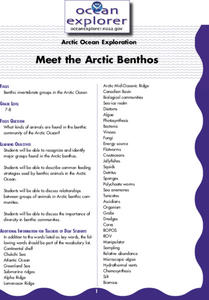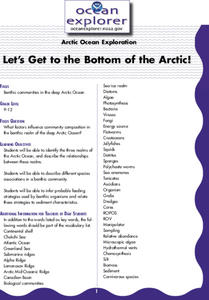Curated OER
Light and Vision
In this light and vision worksheet, students will review the characteristics of light including how the eyes use light to see. This worksheet has 9 fill in the blank, 8 true or false, 9 multiple choice, and 1 short answer question.
Curated OER
Flatworms- Observations of a Live Planarian
In this flatworm worksheet, learners observe a flatworm in a petri dish. Students describe the flatwork and measure the planarian. Learners complete the various charts about the movement and observations of the planarian.
Curated OER
School-Home Links: Spelling Longer Words
In this longer word worksheet, learners review the chunking sound method for spelling longer words. Students then study a list of longer words and select four of them to write on the provided lines. Learners also write a short sentence...
Curated OER
Observing Compost Invertebrates
Second graders examine compost piles and what invertebrates help decompose the organic matter. In this compost invertebrates lesson students collect invertebrates found in a compost pile and examine them.
Curated OER
Sorting
Students explore how books are sorted in a library. In this sorting lesson, students play a game where they have to fill the shelves with books that share a common theme. Students compare this game to a real library. Students discuss how...
Curated OER
Invasion of the Germs: We Fight Back!
Students fight off germs. In this technology skills lesson, students create claymation videos with accompanying podcasts that educate others about the H1N1 virus and methods to fight germs.
Curated OER
Atoms
Eighth graders explain what makes up matter. In this atoms lesson plan students define an atom and what its components are and identify properties of elements.
Curated OER
Sponges and Cnidarian Crossword Puzzle
In this marine science activity, students complete a crossword puzzle with 32 questions on sponges and cnidarian. They identify the different characteristics of sponges and cnidarian.
Curated OER
Reflect and Refract
Young scholars explore light. In this properties of light lesson, students define the terms refract, reflect, and diffract after listening to the teacher's description. Young scholars listen to the book Light Magic and observe a spoon in...
Curated OER
Barnacles: Harder than Cement
Fourth graders watch the movements of the complex animal hidden inside the tiny barnacle shells. This lesson allows students to study the behavior, adaptation, and larval stage of the barnacle.
Curated OER
Pond 1: Pond Life
Learners work together to investigate familiar and unfamiliar ecosystems. Using the internet, they discover how different organisms use their environment to satisfy their needs. They also examine the relationshiops between organisms...
Curated OER
Ecosystems
Sixth graders perform various labs, create presentations, and do hands on activities to explore the ecosystem.
Curated OER
Fertilizer Frenzy
Pupils design and conduct an experiment testing the effect of fertilizers/soaps on algal growth. They estimate and predict, identify the variables, formulate a hypothesis, and record and analyze the data, presenting their findings in a...
Curated OER
Comparative Embryology Using Japanese Medaka Fish
Students conduct an experiment to control the breeding of Japanese Medaka fish. They collect the fertilized eggs and view and record the fish's embryological development daily to compare the stages to human development.
Curated OER
Zebra, Zebra Where Are Your Stripes?
Young scholars observe the embryological development in the zebrafish. Developmental hierarchy from three germ layers is studied in depth. Research is validated on the body plan of the embryo.
Curated OER
Great Salt Lake
Third graders are introduced to the Great Salt Lake (GSL) environment and the various components of it. They make observations about algae and its environment and discuss why it is considered a living organism and various components of...
Curated OER
Cell Theory, Plant And Animal Cell Comparison
Tenth graders study plant and animal cells. In this investigative lesson students draw their own animal cells and label them.
Curated OER
Plants
In this science activity, students investigate plants by first reading a paragraph of information. Students then choose a plant, illustrate and write about it.
Curated OER
Cells
Third graders investigate yeast to extend their understanding of living and non-living things.
Curated OER
Discovering the Oasis
Fourth graders investigate riverbanks and oxbox ecosystem at the Truckee River. They observe the plants, animals, insects and water organisms located there. Students document water samples, flow and then categorize them in class. This...
Curated OER
Biological Communities
Pupils identify consumers and producers in different communities. Students collect a variety of soil samples and record organisms found in the samples.
Curated OER
Meet the Arctic Benthos
Students recognize and identify major groups found in the Arctic benthos. They describe common feeding strategies used by benthic animals in the Arctic Ocean. They discuss relationships between
Curated OER
Let's Get to the Bottom of the Arctic!
Students identify the three realms of the Arctic Ocean, and describe the relationships between these realms. They describe different species associations in a benthic community.
Other popular searches
- Microscope Parts
- Compound Microscope Parts
- Label Microscope Parts
- Microscope Parts Functions
- Identify Microscope Parts
- Biology Lab Microscope Parts
- Microscope Parts Lab
- Microscope Parts and Use
- Microscopes Parts
- Parts of the Microscope Pdf






